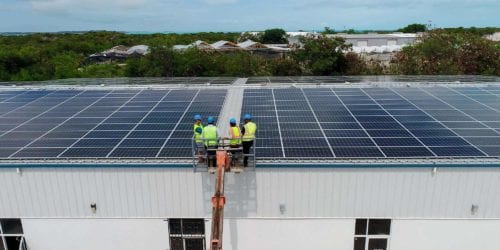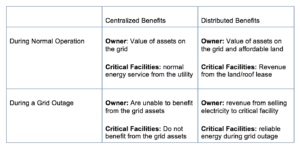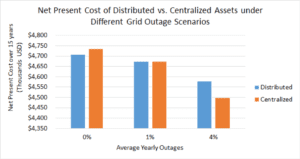
Part Two—Critical Facilities: Where Government and Utility Services Redefine Resilience
In the first part of this two-part series (available here), we explored how the 2017 hurricane season left thousands of homes, businesses, and critical services across the Caribbean in the dark for extended periods of time, and how little benefit backup generators bring to the region’s electrical systems. We related how many islands in the region have created national energy transition plans that call for renewable energy generation assets such as wind, hydro, solar, biomass, geothermal, and battery storage. And we explained how those assets, if distributed across islands and colocated next to critical facilities, can provide value a as part of the utility’s daily operations and provide seamless redundancy and resiliency to serve the island’s most critical services, despite including a cost premium. Here we examine in detail the economics of transitioning to distributed energy resources and explore some of the issues surrounding the process and lessons learned from various examples.
Comparing the costs of centralized vs distributed energy assets
To better understand the tradeoff between the cost premium of distributing renewable generation assets, RMI completed a 15-year net present cost analysis to compare two scenarios:
- A 1 MW solar photovoltaic plant and a 1 MWh battery asset that is centralized
- The same assets, decentralized to four smaller projects located at critical facilities
This analysis took into account land costs, capital costs, and operation and maintenance costs for the two scenarios. In the centralized scenario, we assumed that the benefits of the energy generation were only captured by the asset owner. So when the grid is down, the asset owner could not receive benefits from the solar or storage system. On the other hand, in the distributed scenario, the benefits of the asset are shared between the asset owner and the critical facility across both normal operation and under a grid outage (see Figure 1).
 Figure 1: Benefits for the asset owner and the critical facility during normal grid operation and during a grid outage
Figure 1: Benefits for the asset owner and the critical facility during normal grid operation and during a grid outage
The analysis illustrates that the cost premium for distributing the assets is roughly 8 percent of the capital cost of the system. Most of this cost premium is a result of increased labor cost, some additional logistics costs, and additional interconnection costs of distributing the assets across four separate sites. However, the cost premium is outweighed by the decreased cost of leasing land (or roof space) from a critical facility and by the added revenue of selling electricity to a critical facility when the grid is down (with an annual outage average of 1 percent—see Figure 2).
The cost value of distributing the assets across four critical facilities is the same as centralizing the assets at one utility-owned location.
Figure 2: Net present costs of distributed vs centralized assets under different outage scenarios
Although customers, like critical facilities, may experience grid outages less than 1 percent of the time in a given year, the prolonged grid outages from the 2017 hurricane season illustrate how quickly that can change when faced with a powerful storm. Furthermore, this analysis does not attempt to capture the additional benefit to island society from critical facility services during a grid outage, which would heavily favor the progressive and collaborative distributed scenario.
As is the case in most energy projects, the devil will be in the details. Land cost or lease rates and grid outage projections affect the ability to make up the cost premium for distributing renewable and storage assets. In addition, there is an active debate on whether utilities or customers (or both) should own and operate DERs. But regardless, this initial analysis illustrates that it is worth exploring the costs and benefits of these projects for specific islands.
Optimizing your options
Using solar and battery systems to provide resilience for critical facilities is not a new concept for the electricity industry. Similar trends are happening in the United States, particularly in New Jersey and New York after Hurricane Sandy. But can solar modules really withstand hurricane force winds? Solar assets fared surprisingly well in New Jersey and New York during Hurricane Sandy back in 2012 and, despite the intense Category V wind speeds in the Caribbean last year, a number of high-profile solar assets survived and powered on the next day. But there is still room for improvement across the industry, as outlined in RMI’s recent report Solar under Storm.
Regardless of solar and battery systems being an accepted approach to address resilience with commercial facilities, it can be difficult for facility owners and utilities to truly take advantage and capture the potential benefits of these assets. While plenty of regulatory questions remain, the issue in the United States is primarily around the economics. Because, in general, US grids have a much lower cost of energy than in the Caribbean, so there are active discussions around assigning a separate value for resilience to distributed assets. With the economics not as clear-cut in most of the United States, it will take time and collaboration with utilities, facility owners, and regulators to find proper mechanisms to encourage microgrid deployment. On the other hand, in the Caribbean, microgrids are already cost-competitive with the avoided cost of diesel generation. Caribbean nations can maximize the value of falling prices of solar, wind, and battery assets to become global leaders in microgrid deployment. Whether customer-owned or utility-owned, it is the pure cost-competitiveness of Caribbean microgrids that make legislation and regulation easier to enact. Sensible regulation will be required to ensure renewable energy assets are properly valued on the grid for the utility, the host customer, and all other ratepayers.
RMI’s Islands Energy Program has consulted with many Caribbean nations and overseas territories. Typically, local energy transition has occurred in phases. There is the early vision, followed by an integrated resource plan or a NETS process followed by, or in conjunction with, project implementation. Those initial projects can be small investments, such as energy efficiency measures, or commercial and residential solar, or larger investments, such as Saint Lucia’s 3 MW solar farm or Nevis’ geothermal project. These first phases are critical for stakeholder alignment and establishing mutual benefits across the spectrum of projects and investments. However, it is imperative that islands chart a longer course for transition to further reduce reliance of foreign fuel, improve resilience, provide cost-effective energy and to meet international emissions reductions (from both power generation and transportation).
While the first few phases of transition generally provide some renewable energy penetration (and larger penetrations with geothermal), countries will still need to scale distributed and decentralized assets to accomplish a full transition of both the electricity and the transportation sectors. There is simply not enough usable land on most islands to practically accomplish 100 percent renewable energy with utility-scale generation alone. In addition, as solar and battery systems continue to decline in cost, customers will continue to pressure governments, regulators and utilities to take advantage of the energy savings.
There are several examples of distributed resource transition in the early stages within the region, including a recent solar and battery project announcement from the Government of Antigua & Barbuda. In addition, there are hundreds of microgrid systems currently being planned, installed and operated in Puerto Rico after the devastation of Hurricane Maria.
Global Leadership
The Caribbean is poised to provide global leadership with proven, scalable models for sustainable, resilient, reliable, and cost-effective energy systems. Regional organizations are working to influence governments, regulators, and utilities with the establishment of equitable frameworks for the new reality of energy producers and modern consumers. Organizations such as the Caribbean Community’s Energy Unit (CARICOM) and the Organization of Eastern Caribbean States (OECS) are successfully charting a new course with governments wishing to achieve energy independence and emissions reductions. In fact, over the past five years, there have been major 100-percent renewable energy policy announcements from islands such as Dominica, Barbados, and Montserrat. In the US Territories, the US Department of Energy (DOE) and many NGOs are helping Puerto Rico assess, plan, and properly regulate a new sustainable power system (see RMI’s Resilient and Cost-Effective Energy Future for Puerto Rico). In the US Virgin Islands, DOE and Bloomberg are providing a significant contribution to plan the transition to a more renewable and resilient energy future (see the USVI Hurricane Task Force Report ).
Governments and utilities can redefine resilience together
Enacting policy and establishing new regulations has proved challenging when the regulated market is disrupted quickly by the speed of cost-cutting technological change. However, there has been demonstrated success in energy transition when both the government and the utility have mutual benefits. Renewable energy pilot projects are often used to test both technologies and new frameworks for regulation. If utilities are already investing in solar and storage assets on most Caribbean islands, and customers (including critical facilities) are investing in or being donated solar and storage solutions, why not pilot a mutually beneficial program where critical facilities host a small percentage of grid assets that can seamlessly provide grid services during normal operation and critical power during outages?
The hurricanes of 2017 highlighted yet again our modern society’s vulnerabilities, where power is everything and people suffer without it. A preliminary report from the Government of Puerto Rico to the US Congress includes a number of poignant details about the devastation from the storm and particularly how power outages contributed to the staggering death toll.
But what is different about the hurricane devastation of 2017 compared with widespread disruption of power systems in years past is the prominence of commercially viable renewable energy. It has only been within the last few years that renewable energy systems could complement or even replace the firm and relatively reliable power from diesel generators. That makes seizing this moment in energy transition both a commercial opportunity and a human health and safety priority.

